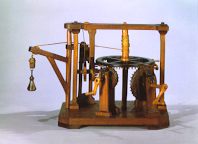
31.3 x 37.5 x 47.4
Carved wood
CAT. 1824 : D.III.34
Modelo d'um guindaste movido por rodas dentadas. N.B. Não se faz caso delle, por estar mal feito.
Model of a crane moved by cogwheels. N.B. It can be disregarded because it is badly made.
This is the most complex of the cranes in the Gabinete de Física.
Its distinguishing feature is the large horizontal cogwheel, mounted on a vertical axle around which is wound the rope for lifting a load. This rope passes trough a pulley at the end of a horizontal beam which moves together with a rotating column. The teeth around the edge of the cogwheel are set laterally, at right angles to the wheel's surface, and engage with three other smaller wheels with horizontal axles and similar lateral teeth. Each of these three control wheels is mounted between two vertical columns and is moved by its own handle.
There are also two other cogwheels, vertical and moving in conjunction on a common axle. One of these two, identical to the three smaller wheels just described, engages also with the horizontal wheel, while the other, which moves together with it, has curved radially-set teeth. A ratchet engages with these teeth, allowing the set of wheels to turn in only one direction and blocking the whole mechanism when not being driven by the handles turning the three control cogwheels. Thus, when the ratchet is pressing on the teeth, the crane keeps the object hanging from the rope. To lower the object, the ratchet is disengaged from the teeth, allowing the mechanism to turn in the opposite direction: this movement is controlled by the handles of the three cogwheels.
This brake ratchet is worked by a rope attached to it at one end. The rope passes through a fixed pulley mounted on a horizontal beam and is then attached to a lever which moves up and down. When the lever arm is pulled down, it raises the ratchet, thereby releasing the brake; the load hanging from the rope can then be lowered. To stop the rotation, the lever must be pushed up, releasing the ratchet which then engages with the cogs.
The column of the crane and its horizontal wooden beam can turn together, and the load, hanging at a certain height, moves horizontally in an arc of circle.